NVIDIA's GeForce GTX 560 Ti: Upsetting The $250 Market
by Ryan Smith on January 25, 2011 9:00 AM ESTCompute & Tessellation
Moving on from our look at gaming performance, we have our customary look at compute performance, bundled with a look at theoretical tessellation performance. Unlike our gaming benchmarks where NVIDIA’s architectural differences between GF114 and GF110 are largely irrelevant, they can become much more important under a compute-bound situation depending on just how much ILP can be extracted for the GTX 560 Ti.
Our first compute benchmark comes from Civilization V, which uses DirectCompute to decompress textures on the fly. Civ V includes a sub-benchmark that exclusively tests the speed of their texture decompression algorithm by repeatedly decompressing the textures required for one of the game’s leader scenes.
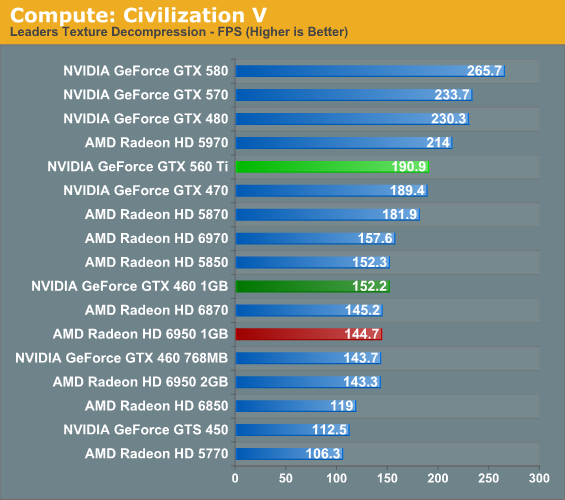
Under our Civilization 5 compute benchmark we have a couple of different things going on even when we just look at the NVIDIA cards. Compared to the GTX 460 1GB, the GTX 560 enjoys a 31% performance advantage; this is less than the theoretical maximum of 39%, but not far off from the performance advantages we’ve seen in most games. Meanwhile the GTX 470 is practically tied with the GTX 560 even though on paper the GTX 560 has around a 15% theoretical performance advantage. This ends up being a solid case of where the limitations of ILP come in to play, as clearly the GTX 560 isn’t maximizing the use of its superscalar shaders. Or to put it another way, it’s an example as to why NVIDIA isn’t using a superscalar design on their Tesla products.
Meanwhile this benchmark has always favored NVIDIA’s architectures, so in comparison to AMD’s cards there’s little to be surprised about. The GTX 560 Ti is well in the lead, with the only AMD card it can’t pass being the dual-GPU 5970.
Our second GPU compute benchmark is SmallLuxGPU, the GPU ray tracing branch of the open source LuxRender renderer. While it’s still in beta, SmallLuxGPU recently hit a milestone by implementing a complete ray tracing engine in OpenCL, allowing them to fully offload the process to the GPU. It’s this ray tracing engine we’re testing.
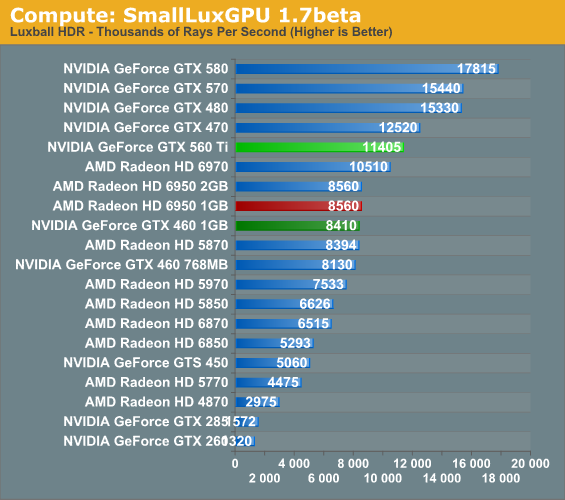
Small Lux GPU is the other test in our suite where NVIDIA’s drivers significantly revised our numbers. Where this test previously favored raw theoretical performance, giving the vector-based Radeons an advantage, NVIDIA has now shot well ahead. Given the rough state of both AMD and NVIDIA’s OpenCL drivers, we’re attributing this to bug fixes or possibly enhancements in NVIDIA’s OpenCL driver, with the former seeming particularly likely. However NVIDIA is not alone when it comes to driver fixes, and AMD has seem a similar uptick against the newly released 6900 series. It’s not nearly the leap NVIDIA saw, but it’s good for around 25%-30% more rays/second under SLG. This appears to be accountable to further refinement of AMD’s VLIW4 shader compiler, which as we have previously mentioned stands to gain a good deal of performance as AMD works on optimizing it.
So where does SLG stack up after the latest driver enhancements? With NVIDIA’s rocket to the top, they’re now easily dominating this benchmark. The GTX 560 Ti is now slightly ahead of the 6970, never mind the 6950 1GB where it has a 33% lead. Rather than being a benchmark that showed the advantage of having lots of theoretical compute performance, this is now a benchmark that seems to favor NVIDIA’s compute-inspired architecture.
Our final compute benchmark is a Folding @ Home benchmark. Given NVIDIA’s focus on compute for Fermi, cards such as the GTX 560 Ti can be particularly interesting for distributed computing enthusiasts, who are usually looking for a compute card first and a gaming card second.
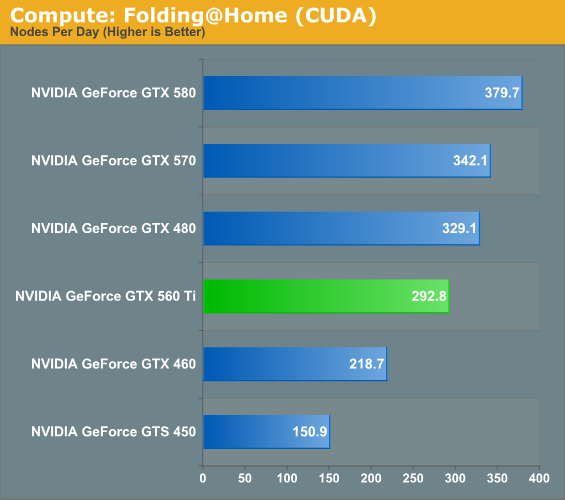
Against the senior members of the GTX 500 series and even the GTX 480 the GTX 560 Ti is still well behind, but at the same time Folding @ Home does not look like it significantly penalizes GTX 560’s superscalar architecture.
At the other end of the spectrum from GPU computing performance is GPU tessellation performance, used exclusively for graphical purposes. With Fermi NVIDIA bet heavily on tessellation, and as a result they do very well at very high tessellation factors. With 2 GPCs the GTX 560 Ti can retire 2 triangles/clock, the same rate as the Radeon HD 6900 series, so this should be a good opportunity to look at theoretical architectural performance versus actual performance.
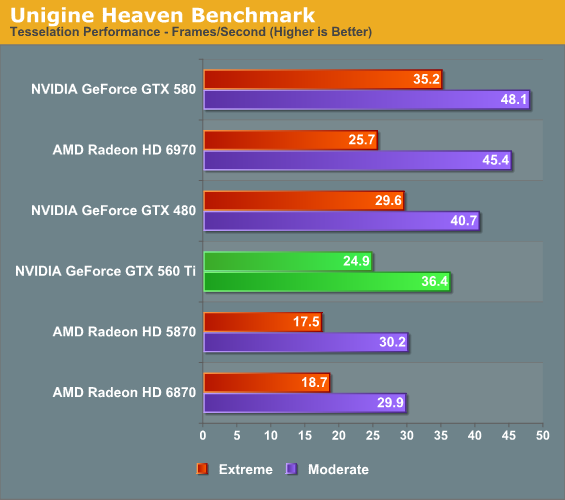
Against the AMD 5800 and 6800 series, the GTX 560 enjoys a solid advantage, as it’s able to retire twice as many triangles per clock as either architecture. And while it falls to both GTX 480 and GTX 580, the otherwise faster Radeon HD 6970 is close at times – at moderate tessellation it has quite the lead, but the two are neck-and-neck at extreme tessellation where triangle throughput and the ability to efficiently handle high tessellation factors counts for everything. Though since Heaven is a synthetic benchmark at the moment (the DX11 engine isn’t currently used in any games) we’re less concerned with performance relative to AMD’s cards and more concerned with performance relative to the other NVIDIA cards.
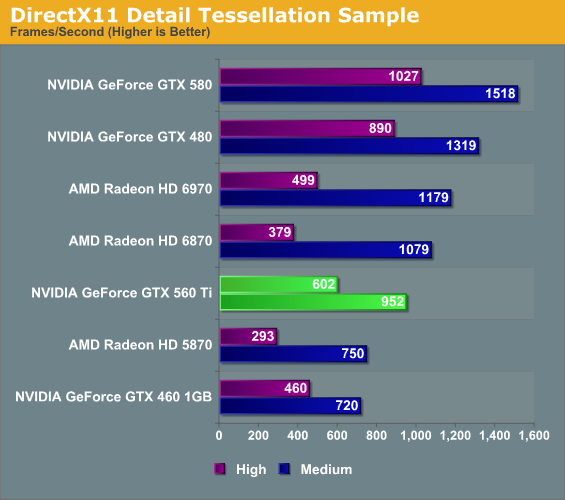
Microsoft’s Detail Tessellation sample program showcases NVIDIA’s bet on tessellation performance even more clearly. NVIDIA needs very high tessellation factors to shine compared to AMD’s cards. Meanwhile against the GTX 460 1GB our gains are a bit more muted; even though this is almost strictly a theoretical test, the GTX 560 only gains 30% on the GTX 460. Ultimately while the additional SM unlocks another tessellator on NVIDIA’s hardware, it does not unlock a higher triangle throughput rate, which is dictated by the GPCs.










87 Comments
View All Comments
heflys - Tuesday, January 25, 2011 - link
Well, at least they have the distinction of being the only site (that I've seen thus far) to say the 560 is faster than the 6950. It's just laughable, IMHO, that they'd feature several titles known to favor Nvidia (with results showing the 560 beating top-tier AMD cards), yet still reach the conclusion that the 560 is "faster" at stock.I've been slowly taking AT less and less seriously.........Thank goodness for their benching charts.
ritalinkid18 - Tuesday, January 25, 2011 - link
One thing I've noticed about the comments so far... every single person disagreeing with the conclusion ends up agreeing conclusion in their reasoning.i.e. "what games you play"
"The deciding factor seems to come down to just how much to value noise and cooling (560) versus power consumption (6950), what games you play, and whether you’re currently invested in the NVIDIA (CUDA, 3D Vision) or AMD (Eyefinity) ecosystem."
heflys - Tuesday, January 25, 2011 - link
Well, in that case, Anand is contradicting themselves.....Since (using that logic) the 560 wouldn't be "a bit faster" in performance, or have the overall edge. In other words, they wouldn't be able to conclude which card is "faster." They're conclusion of "faster" is based on their own benchmarks.Ryan Smith - Tuesday, January 25, 2011 - link
To be clear, on my master charts the GTX 560 Ti has an average of a 2% performance lead over the 6950 1GB at 1920, and a 10% performance lead at 1680. This doesn't preclude the fact that performance varies wildly by game; it only means that on average the GTX 560 Ti was faster.heflys - Tuesday, January 25, 2011 - link
Not surprising looking at the results in HAWX, Civ 5 and Dirt 2.Touche - Wednesday, January 26, 2011 - link
That's just a terrible way to reach a performance conclusion, in so many ways. Then again, the number of people taking Anandtech's (GPU) reviews seriously is smaller every day. I miss the years it was practically my homepage and main reference point.dananski - Tuesday, January 25, 2011 - link
I was puzzled by your comment (and others'). It seemed to me that while the 560 and 6950 1GB were changing relative position in the charts, the 560 really wins hard when it does win, so it would come out slightly above the 6950 on average.Plus, I'd prefer a card that does well every time (the 560) but gets slightly beaten occasionally, rather than a card that does well most of the time but really falls behind in certain games.
heflys - Tuesday, January 25, 2011 - link
People are always jaded when it comes to games that show a significant bias for a particular manufacturer. In the case of Civ 5, HAWX and Dirt 2 (as of late); these titles favor Nvidia products. If you look at the benches, the 560 is even beating a 6970 in some instances.qwsa - Tuesday, January 25, 2011 - link
Anandtech has always had their nose up Nvidia and intels ass so no surprise there, but what a lousy conclusion to an awfull review. Apparently Anandtechs efforts to find good writers were in vane.silverblue - Tuesday, January 25, 2011 - link
Please... let's not start this again...